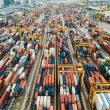Table of Contents Show
Introduction
China’s rise from the devastation of the Cultural Revolution to its position today as the world’s second-largest economy is nothing short of a historical anomaly. With an economic system that fuses state control with capitalist elements, the People’s Republic of China (PRC) has become a case study in paradoxes. For some, China represents a triumph of central planning over the chaos of free markets. For others, its rapid growth belies deep, systemic risks that threaten global economic stability. The question at hand: How sustainable is China’s economic model, and who wins or loses in its continued ascension?
To understand China’s economic model, one must first recognize the deliberate orchestration of its growth by the Chinese Communist Party (CCP), its iron grip on power, and how it deploys that power across the sectors it deems essential to its national strategy. This story, however, is not just about GDP numbers or trade surpluses—it’s about the intricate dance between centralized control and the lure of market freedom, the social consequences of rapid development, and the international ramifications of China’s rise.
The Machinery of Centralized Capitalism
At the heart of China’s economic system lies a hybrid model that marries the state’s extensive reach with elements of free market capitalism. On one hand, private enterprise flourishes, especially in sectors like technology, real estate, and manufacturing, where nimble firms like Huawei and Alibaba have risen to global prominence. On the other hand, the state retains control over the commanding heights of the economy, such as banking, energy, and telecommunications.
This dual structure has allowed the Chinese economy to grow at an average of nearly 10% annually over the past three decades, lifting over 800 million people out of poverty—a feat unprecedented in human history. The Chinese government has not hesitated to direct resources where it sees fit, often using its vast state-owned enterprises (SOEs) to implement large-scale infrastructure projects, control key industries, and even weather international trade disputes.
However, this model also exposes inherent contradictions. The intertwining of state and private enterprise raises questions about efficiency, innovation, and transparency. How can a system dominated by state ownership truly thrive in a global economy that rewards competition, flexibility, and risk-taking? Can China maintain its explosive growth, or is it a ticking time bomb of inefficiencies?
Pros: Growth, Infrastructure, and Strategic Industries
One cannot discuss China’s economy without acknowledging its remarkable successes. The PRC has built infrastructure on a scale the world has never seen. High-speed rail systems connect the country’s vast urban centers; airports, highways, and bridges are constructed at breakneck speed; and entire megacities have risen seemingly overnight. These projects—often funded and implemented by state-run companies—are key to China’s ambitions of becoming a global superpower.
China’s centralized planning allows it to mobilize resources and execute long-term strategies that would be politically unthinkable in Western democracies. When the CCP decides that artificial intelligence or electric vehicles are crucial industries for the future, it allocates massive investments to develop and dominate those sectors. This is most apparent in the Belt and Road Initiative (BRI), China’s global infrastructure strategy that aims to extend its influence across Asia, Africa, and Europe.
Furthermore, China’s central bank, the People’s Bank of China, has the authority to adjust financial levers without the bureaucracy and political gridlock that characterizes other major economies. By controlling interest rates, exchange rates, and banking practices, China can smooth out economic fluctuations and maintain relative financial stability, as it did during the global financial crisis of 2008, when its swift stimulus package staved off recession.
This ability to tightly control the economy, however, is also its Achilles heel.
Cons: Debt, Inefficiencies, and the Authoritarian Trap
As much as China’s system has driven growth, it has also created structural weaknesses. One of the most significant concerns is the country’s mounting debt. Much of China’s infrastructure boom has been financed through borrowing, particularly at the local government level. The debt-to-GDP ratio continues to climb, and analysts warn that the country’s debt is approaching unsustainable levels. The property market, once a primary engine of growth, now faces severe challenges, as demonstrated by the collapse of Evergrande, a real estate giant that has sent shockwaves through China’s financial system.
Additionally, China’s reliance on SOEs comes with enormous inefficiencies. These enterprises, while pivotal to the state’s control of key sectors, often operate with little regard for profitability. They are cushioned by the state and insulated from competition, leading to bloated workforces, misallocation of resources, and in some cases, corruption. The private sector, on the other hand, faces growing pressure from the government. Recent crackdowns on tech firms, such as the suspension of Ant Group’s IPO and fines against Alibaba, have sent a chilling message to entrepreneurs: in China, business success must align with the party’s objectives, or it will be swiftly curtailed.
Moreover, China’s authoritarian system, while allowing for decisive economic interventions, stifles dissent and limits transparency. The CCP’s control over information makes it nearly impossible to trust the data it provides, from official GDP numbers to statistics on unemployment and poverty. This lack of transparency is a ticking time bomb that could lead to miscalculations both within China and among its trading partners.
The human cost of China’s economic model is also staggering. Forced labor camps, especially in Xinjiang, have raised alarms in the international community. The government’s suppression of worker rights, particularly in industries dominated by migrant labor, has allowed for a race to the bottom in terms of wages and working conditions. While this has enabled the mass production of cheap goods, it comes at the cost of human dignity and well-being.
Geopolitical Ramifications: Friend or Foe?: Debt, Inefficiencies, and the Authoritarian Trap
China’s rise is not merely an economic story—it is a geopolitical one. The country’s growing influence has alarmed the West, particularly the United States, which sees China as its primary strategic rival. From trade wars to technology bans, the U.S. and its allies are grappling with how to contain China’s economic power without disrupting global markets.
China’s economic leverage extends far beyond its borders. Through initiatives like the BRI, it has entrenched itself in the economies of over 60 countries, offering loans and investments in exchange for political and economic influence. While some nations have welcomed Chinese capital, others have grown wary of becoming too dependent on Beijing. The “debt trap” diplomacy accusation, where China allegedly extends loans knowing recipient countries will struggle to repay, has garnered significant attention.
Technology is another battleground. China’s advances in areas such as 5G and artificial intelligence have made it a leader in critical industries that the West has traditionally dominated. The rise of companies like Huawei has created friction, as the U.S. and its allies fear that Chinese tech firms may serve as Trojan horses for espionage. The tech war is no longer about market competition—it’s about national security.
Furthermore, China’s economic model, with its emphasis on state control and strategic sectors, challenges the liberal capitalist order that has defined global trade for decades. The World Trade Organization (WTO) and other international institutions are struggling to adapt to China’s unique system, which does not neatly fit into the free-market framework. As China asserts its influence, it forces the world to confront a fundamental question: Can Western democracies and authoritarian states like China peacefully coexist in a globalized economy?
Conclusion: The Road Ahead
The Chinese economy is an enigma—a combination of brilliant planning, authoritarian control, and relentless ambition. It has achieved remarkable success, transforming a once-impoverished nation into a global superpower. Yet, its long-term sustainability remains uncertain. The cracks in the façade are beginning to show: rising debt, inefficiencies in state-run enterprises, growing inequality, and the CCP’s unrelenting suppression of dissent.
For now, China remains a force to be reckoned with, but it is walking a fine line. If the country can address its internal contradictions, manage its debt, and balance its authoritarian instincts with the needs of a dynamic economy, it may continue its rise. However, if the weight of its contradictions becomes too much to bear, China’s story could shift from one of ascendancy to one of stagnation.
As the West grapples with how to respond to China’s rise, one thing is certain: China’s economic model will continue to be a source of both admiration and concern. The world will watch with bated breath to see whether China’s hybrid system—centralized, yet capitalist—can stand the test of time, or whether it will crumble under its own weight.




